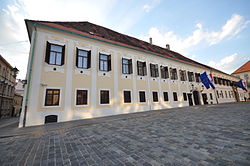| Ban's Court | |
|---|---|
Banski dvori | |
 The main façade of Banski Dvori | |
 | |
| Alternative names | Government Building |
| General information | |
| Architectural style | Baroque Classicism |
| Location | Gornji Grad–Medveščak |
| Address | 1-2 St. Mark's Square |
| Town or city | Zagreb |
| Country | Croatia |
| Coordinates | 45°48′59″N 15°58′23″E / 45.81639°N 15.97306°E |
| Current tenants | Government of Croatia |
| Completed | 18th century |
| Owner | Republic of Croatia |
| Technical details | |
| Floor count | 3 |
Banski Dvori (pronounced [bâːnskiː dvɔ̌ːri]; "Ban's Court") is a historical building on the west side of St. Mark's Square in Zagreb, Croatia. It served as the official residence of the Croatian Bans (viceroys) and currently houses the Croatian Government.
The Banski Dvori is a two-story baroque building constructed by Ignaz Gyulai in the first half of the 19th century. It was the residence of Croatian bans from 1809 to 1918, hence the name Banski Dvori ("Ban's Court"). During this period, it housed the Tabula Banalis and later the Royal Court Table. Ban Josip Jelačić, for whom Ban Jelačić Square is named, was a resident of Banski Dvori.[1]
During World War II and the so-called Independent State of Croatia (1941–1945) it served as the office of Poglavnik Ante Pavelić and was called Poglavnikovi dvori (Poglavnik's Court). Between 1945 and 1991, the period of the SFR Yugoslavia, the Banski Dvori was the official residence of the Presidency of the Socialist Republic of Croatia. In May 1990, it became the official residence of the President and the Government of Croatia. On October 7, 1991, the Yugoslav People's Army carried out an airstrike targeted at President Franjo Tuđman, President of Presidency of Yugoslavia Stipe Mesić, and President of the Federal Executive Council of Yugoslavia Ante Marković. All survived the attack. On the following day, the Croatian Parliament declared independence of Croatia from Yugoslavia. In 1992, the President moved its residence to the Presidential Palace.
- ^ The Upper Town Zagreb, Gornji grad (2014 ed.). Zagreb: Izdavac. p. 12.